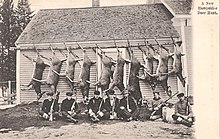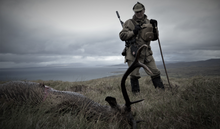Deer hunting


Deer hunting is hunting for deer for meat or sport, an activity which dates back tens of thousands of years. Venison, the name for deer meat, is a nutritious and natural food source of animal protein that can be obtained through deer hunting. There are many different types of deer around the world that are hunted for their meat.
Hunting deer is a regulated activity in many territories. In the US, a state government agency such as a Department of Fish and Wildlife (DFW) or Department of Natural Resources (DNR) oversees the regulations. In the United Kingdom, it is illegal to use bows or rifles chambered in bores smaller than .243 caliber (6mm) for hunting.[1]
New Zealand[]
New Zealand has had 10 species of deer (Cervidae) introduced. From the 1850s, red deer were liberated, followed by fallow, sambar, wapiti, sika, rusa, and whitetail. The introduced herds of axis and moose failed to grow, and have become extinct. In the absence of predators to control populations, deer were thought to be a pest due to their effect on native vegetation. From the 1950s, the government employed professional hunters to cull the deer population. Deer hunting is now a recreational activity, organised and advocated for at the national level by the New Zealand Deerstalkers' Association.[2]
United States[]

The two main species of deer found in the United States are mule deer and white-tailed deer. Mule deer are mostly found west of the Rocky Mountains, but can also be found as far east as parts of North and South Dakota, while whitetails generally occur only to the east of the Rockies. Mule deer have a black-tipped tail which is proportionally smaller than that of the white-tailed deer. The male deer or bucks grow antlers annually. The mule deer have taller skinnier tines on their antlers where white-tailed deer typically have shorter thicker tines. White-tailed bucks are slightly smaller than mule deer bucks.[citation needed] Both of the species lose their antlers in January, and regrow the antlers during the following summer beginning in June. Although both species are found in the United States, where they are found is vastly different. Mule deer are found in the western United States in the foothills of the mountains.
As their antlers become fully developed, they will start to shed their velvet. Velvet is vascularised tissue that is a furry skin-like material that covers the growing antlers. The velvet will fall off of the deer when their antlers start to harden in late summer to early fall to get ready for mating season in the winter. If the velvet doesn't fall off on its own they will make a "rub" on a small tree. This is when they rub their antlers to both mark territory and to take the remaining velvet off.
State government regulation[]
Methods of pursuing game for wild meat and corresponding seasons are subject to regulation by state governments and therefore vary from state to state. A state government agency such as a Department of Fish and Wildlife (DFW) or Department of Natural Resources (DNR) oversees the regulations.
Deer hunting seasons vary across the United States. In game zone 3 in the state of South Carolina, deer hunting season starts August 15 and runs through January 1. Some seasons in states such as Florida and Kentucky[3] start as early as September and can go all the way until February like in Texas. The length of the season is often based on the health and population of the deer herd, in addition to the number of hunters expected to be participating in the deer hunt. The duration of deer hunting seasons can also vary by county within a state, as in Kentucky.[3] In the case of South Carolina, the season varies by SCDNR region. Each region has multiple counties. The DFW will also create specific time frames within the season where the number of hunters able to hunt is limited, which is known as a controlled hunt.
The DFW may also break the deer-hunting season into different time periods where only certain weapons are permitted: bows only (compound, recurve, and crossbows), modern firearms (rifles and shotguns) or black-powder muzzleloaders. (Some states, such as Kentucky,[3] consider only compound and recurve bows as "bows" for hunting regulation purposes, and have special seasons for crossbows.)[4] For example, during a bows-only season, in many areas a hunter would be limited to the use of a bow and the use of any firearm would be prohibited until that specific season opens, and in some areas a crossbow can only be used during a dedicated season for that weapon. Similarly, during a muzzleloader season, use of modern firearms is almost always prohibited. However, in many states, the archery season (at least for compound and recurve bows) completely overlaps all firearms seasons; in those locations, bowhunters may take deer during a firearms season.
Some states also have restrictions on hunting of antlered or antlerless deer. For example, Kentucky allows the taking of antlerless deer during any deer season in most of the state, but in certain areas allows only antlered deer to be taken during parts of deer season.[3]
United Kingdom and Republic of Ireland[]

The term "deer hunting" is used in North America for the shooting of deer, whilst in Britain and Ireland the term generally refers to the pursuit of deer with scent hounds, with unarmed followers typically on horseback.[citation needed]
There are six species of deer in the UK: red deer, roe deer, fallow deer, Sika deer, Reeves muntjac deer, and Chinese water deer, as well as hybrids of these deer. All are hunted to a degree reflecting their relative population either as sport or for the purposes of culling. Closed seasons for deer vary by species.[5] The practice of declaring a closed season in England dates back to medieval times, when it was called fence month and commonly lasted from June 9 to July 9, though the actual dates varied.[6] It is illegal to use bows to hunt any wild animal in the UK under the Wildlife and Countryside Act 1981.
UK deer stalkers, if supplying venison (in fur) to game dealers, butchers and restaurants, need to hold a Lantra level 2 large game meat hygiene certificate. Courses are run by organisations such as the British Association for Shooting and Conservation and this qualification is also included within the Level 1 deer stalking certificate. If supplying venison for public consumption (meat), the provider must have a fully functioning and clean larder that meets FSA standards and must register as a food business with the local authority.[7]

The vast majority of deer hunted in the UK are stalked. The phrase deer hunting is used to refer (in England and Wales) to the traditional practice of chasing deer with packs of hounds, currently illegal under the Hunting Act 2004.
In the late nineteenth and twentieth centuries, there were several packs of staghounds hunting "carted deer" in England and Ireland. Carted deer were red deer kept in captivity for the sole purpose of being hunted and recaptured alive. More recently, there were three packs of staghounds hunting wild red deer of both sexes on or around Exmoor and the New Forest Buckhounds hunting fallow deer bucks in the New Forest, the latter disbanding in 1997.
The practice of hunting with hounds, other than using two hounds to flush deer to be shot by waiting marksmen, has been banned in the UK since 2005; to date, two people have been convicted of breaking the law.[8]
There is one pack of stag hounds in the Republic of Ireland and one in Northern Ireland,[9] the former operating under a licence to hunt carted deer.[10]
Australia[]
In Australia, there are six species of deer that are available to hunt. These are Fallow deer, Sambar, Red deer, Rusa, Chital, and Hog deer.[11]
Gallery[]

The Goguryeo tomb mural of hunting from Ji'an
A painting of the goddess Diana deer hunting by Peter Rubens

Theodore Roosevelt in 1885 with his highly decorated deer-skin hunting suit, and Tiffany-carved hunting knife and rifle
See also[]
- Big Buck Hunter
- Deer Act 1980 (in the UK)
- Deer farm
- Deer horn
- Deer day
- Deer Hunter - video game
- Deer Avenger - video game
- Deerskin trade
- TheHunter - video game
- Hole in the Horn Buck
- James Jordan Buck
- Reindeer hunting in Greenland
- Venison
References[]
- ^ "Deer Act 1963 Chapter 36". The National Archives. Schedule 2: "Prohibited Firearms and Ammunition". 1963. Accessed March 2, 2021.
- ^ "Hunting today". Te Ara Encyclopedia of New Zealand.
- ^ Jump up to: a b c d "Deer Hunting Zones and Seasons". Kentucky Department of Fish & Wildlife Resources. Retrieved January 23, 2015.
- ^ Wexel, Mike (January 14, 2017). "Deer Hunting Season in the United States". Peak Wilderness. Retrieved April 25, 2017.
- ^ Naturenet: Shooting, Hunting and Angling Seasons. Naturenet - Countryside Management & Nature Conservation.
- ^ Forests and Chases of England and Wales: A Glossary. St John's College, Oxford.
- ^ The Wild Game Guide - Food Standards Agency Retrieved June 24, 2017.
- ^ "Hunting duo appeal is turned down". BBC News. October 19, 2007. Retrieved May 1, 2010.
- ^ Cassidy, Martin (February 8, 2005). "Frustrations of hunter and hunted". BBC News. Retrieved May 1, 2010.
- ^ [1] Archived November 23, 2007, at the Wayback Machine
- ^ Game Council NSW Archived May 19, 2009, at the Wayback Machine
External links[]
![]() Media related to Deer hunting at Wikimedia Commons
Media related to Deer hunting at Wikimedia Commons
- Deer hunting
- Dog sports




